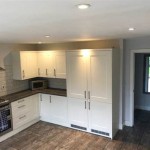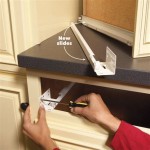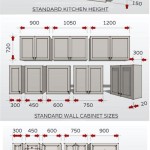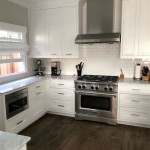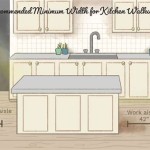Refacing Kitchen Cabinets: DIY Ideas to Transform Your Space
A kitchen renovation can be a significant undertaking, both in terms of time and budget. But if you're looking to give your kitchen a fresh look without the hassle and expense of a complete overhaul, refacing your cabinets might be the perfect solution. Refacing involves replacing the doors, drawer fronts, and hardware of your existing cabinets, while keeping the cabinet boxes in place. This process can dramatically change the appearance of your kitchen, giving it a modern, updated aesthetic.
Taking on a DIY kitchen cabinet refacing project can be a rewarding experience, allowing you to customize your kitchen to your exact taste and save a significant amount of money. Here are some ideas and considerations to help you successfully transform your cabinets and achieve your desired kitchen look.
Choosing the Right Materials
The first step in refacing your cabinets is selecting the right materials. You'll need to decide on new cabinet doors, drawer fronts, and hardware. Here are some popular options to consider:
- Wood: This is a classic and durable option that offers a timeless look. You can choose from various wood types, finishes, and stains to achieve your desired aesthetic.
- Painted Doors: If you're looking for a more modern look, painted cabinet doors are an excellent choice. They can be painted in any color you like, providing endless possibilities for customization.
- Thermofoil: Thermofoil doors are made from MDF (medium-density fiberboard) with a thin plastic laminate applied to the surface. They're very durable and are available in a wide range of colors and finishes.
- Vinyl Wrap: This is a cost-effective and easy-to-apply option that can give your cabinets a new look without the need for painting or staining.
When choosing materials, consider factors such as your personal style, the existing style of your kitchen, and your budget. Additionally, take into account the condition of your existing cabinets. If they're in good shape, refacing can be a simple solution. However, if the cabinets are damaged or warped, you might need to consider replacing them entirely.
Preparing for the Refacing Process
Before you begin refacing your cabinets, there are a few preparatory steps to take. These include:
- Planning and Measuring: Carefully measure your existing cabinets to ensure you order the right size doors and drawer fronts. Consider the style and size of your new hardware and how it will complement the overall look of your kitchen.
- Removing Existing Hardware: Remove all existing cabinet hardware, including hinges, knobs, and pulls. Make sure to keep these items in a safe place, as you may be able to reuse them or use them as templates for new hardware.
- Cleaning and Sanding: Clean your cabinet boxes thoroughly, removing any dirt, grease, or grime. If you're using wood doors or drawer fronts, you may need to sand them before applying any finishes.
- Preparing the Work Area: Clear the area around your cabinets and cover countertops and floors to protect them from paint, dust, or other debris.
Taking the time to prepare for the refacing process will make the project go much smoother and ensure a better final outcome.
Installing the New Doors and Drawer Fronts
Once you've chosen your materials and prepared your cabinets, you can begin installing the new doors and drawer fronts. While this process can seem daunting, it is achievable with patience and the right tools. Here are some key steps:
- Installing Hinges: Attach the new hinges to your cabinet doors using screws or a drill. Ensure the hinges are perfectly aligned and flush with the doors. Consider using a template for accurate placement.
- Attaching Doors to Cabinets: Attach the doors to the cabinet boxes using the newly installed hinges. Make sure the doors are level and aligned. You may need to adjust the hinges to ensure a proper fit.
- Installing Drawer Fronts: Install the new drawer fronts using screws or a drill, ensuring they are securely attached to the existing drawer boxes. Use a level to ensure they are aligned and flush with the cabinet face frame.
- Installing Hardware: Once the doors and drawer fronts are installed, you can attach the new hardware. Use a drill to create pilot holes for the screws, ensuring they are positioned correctly to avoid splitting the wood.
After completing these steps, you will have a fresh new look for your kitchen cabinets, transforming the overall appearance of your space.
Following these DIY refacing tips will help you make your kitchen a more beautiful and functional space. With careful planning and execution, you can complete the project with success and enjoy your new kitchen cabinets. Remember to consult with a professional if you encounter any difficulties or have concerns about the project.

10 Diy Cabinet Refacing Ideas

How To Reface Kitchen Cabinets Affordable Cabinet Update On A Budget Anika S Diy Life

Diy Cabinet Refacing Budget Friendly Made Easy Wisewood

Diy Cabinet Refacing Budget Friendly Made Easy Wisewood

Best Kitchen Cabinet Refacing For Your Home The Depot

10 Diy Cabinet Refacing Ideas

How To Reface Kitchen Cabinets Affordable Cabinet Update On A Budget Anika S Diy Life

Kitchen Cabinet Refacing By Improveit

Diy Cabinet Refacing On A Budget Flexseals Com

Reface Your Kitchen Cabinets Easy Diy Remodel
Related Posts

